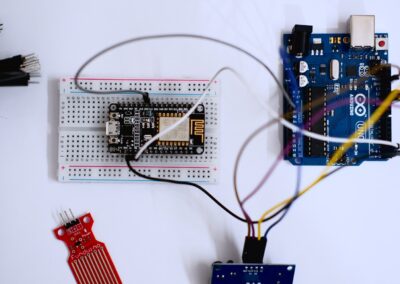Strategies for Securing IoT Device Firmware
Understanding the Importance of Firmware Security
Securing IoT device firmware is a critical aspect of protecting the integrity and functionality of connected devices. As IoT devices proliferate across Saudi Arabia, the UAE, and cities like Riyadh and Dubai, ensuring the security of firmware against tampering is crucial for maintaining operational reliability and safeguarding sensitive data. Firmware, the software embedded in IoT devices, controls the device’s hardware and functions. Any vulnerability or tampering in the firmware can lead to significant security breaches, impacting business operations and consumer trust.
To effectively secure IoT device firmware, businesses must implement robust security strategies. This includes adopting encryption techniques to protect firmware code from unauthorized access. Advanced encryption algorithms can render firmware code unreadable to potential attackers, making it difficult for them to exploit vulnerabilities. Additionally, employing code obfuscation techniques can further complicate reverse engineering efforts, adding an extra layer of protection against tampering.
Moreover, regular firmware updates are essential for addressing newly discovered vulnerabilities. Establishing a secure update mechanism ensures that only authenticated and verified firmware versions are installed on devices. This helps prevent attackers from injecting malicious code through compromised updates, thus enhancing the overall security posture of IoT systems.
Implementing Secure Boot Processes
Enforcing secure boot processes is a key strategy for protecting IoT device firmware from tampering. Secure boot ensures that only trusted firmware is loaded during the device’s startup process, preventing unauthorized or malicious code from executing. This process begins with the device’s hardware verifying the integrity of the firmware before allowing it to run.
Secure boot typically involves using cryptographic signatures to authenticate the firmware. When a device starts, it checks the digital signature of the firmware against a trusted certificate stored in the device’s hardware. If the firmware’s signature is valid, the device proceeds with the boot process. If the signature is invalid or missing, the device halts the boot process to prevent potential security breaches.
Implementing secure boot requires careful planning and integration with the device’s hardware and firmware architecture. For businesses in regions like Saudi Arabia and the UAE, collaborating with technology partners who specialize in secure boot solutions can help ensure that the implementation is effective and meets industry standards. This collaboration can also provide valuable insights into best practices for maintaining firmware security throughout the device’s lifecycle.
Leveraging Advanced Technologies for Enhanced Security
Modern technologies, including artificial intelligence (AI) and blockchain, offer innovative solutions for securing IoT device firmware. AI can be employed to detect and respond to anomalous behavior indicative of tampering or security breaches. Machine learning algorithms can analyze firmware patterns and identify deviations from expected behavior, enabling proactive security measures and rapid response to potential threats.
Blockchain technology can enhance firmware security by providing a tamper-proof ledger for firmware updates and integrity checks. Each firmware update can be recorded on a blockchain, creating an immutable record of all changes and ensuring transparency and accountability. This approach not only enhances the security of firmware updates but also facilitates traceability and auditability, providing an additional layer of protection against tampering.
For businesses in Dubai and Riyadh, integrating these advanced technologies into their security strategies can provide a competitive edge. By adopting cutting-edge solutions and staying ahead of emerging threats, organizations can enhance their overall security posture and safeguard their IoT ecosystems.
Best Practices for Enforcing Secure Boot and Firmware Protection
Establishing Comprehensive Security Policies
Developing and implementing comprehensive security policies is essential for enforcing secure boot processes and protecting IoT device firmware. These policies should outline procedures for firmware updates, secure boot implementation, and response to security incidents. Additionally, policies should include guidelines for regular security assessments and audits to ensure that security measures remain effective and up-to-date.
For executives and managers in Saudi Arabia and the UAE, investing in executive coaching services can help enhance their understanding of cybersecurity best practices and ensure that security policies align with organizational goals. Effective leadership and management skills are crucial for overseeing the implementation of these policies and fostering a culture of security within the organization.
Collaborating with Industry Experts
Collaboration with industry experts is a key factor in successfully securing IoT device firmware. Engaging with cybersecurity professionals and technology partners who specialize in firmware protection and secure boot processes can provide valuable insights and support. These experts can assist in selecting and implementing the most effective security solutions, as well as providing ongoing support and guidance.
In regions like the UAE and Saudi Arabia, where technological advancements are rapidly evolving, staying informed about the latest developments in cybersecurity is crucial. Industry conferences, workshops, and networking events can offer opportunities to learn about emerging technologies and best practices, helping businesses stay ahead of potential threats.
Investing in Ongoing Training and Awareness Programs
Ongoing training and awareness programs are essential for maintaining a high level of security awareness among employees. Providing regular training on cybersecurity best practices, secure boot processes, and firmware protection can help ensure that all team members understand their role in safeguarding IoT devices. Additionally, fostering a culture of security awareness can contribute to a more proactive approach to identifying and addressing potential vulnerabilities.
For entrepreneurs and business leaders in Dubai and Riyadh, investing in comprehensive training programs can enhance their team’s ability to implement and maintain effective security measures. By staying informed about the latest threats and best practices, organizations can better protect their IoT devices and achieve long-term success.
In conclusion, securing IoT device firmware from tampering is a multifaceted challenge that requires a combination of strategies and best practices. By implementing robust security measures, enforcing secure boot processes, leveraging advanced technologies, and investing in ongoing training and collaboration, businesses can enhance the security of their IoT ecosystems and protect their operations from potential threats. For regions like Saudi Arabia and the UAE, where technological innovation is a driving force, adopting these strategies is essential for ensuring the continued success and reliability of connected devices.
—
#IoTSecurity #FirmwareProtection #SecureBoot #TamperingPrevention #SaudiArabia #UAE #Riyadh #Dubai #ArtificialIntelligence #Blockchain #GenerativeAI #ModernTechnology #BusinessSuccess #LeadershipSkills #ProjectManagement































